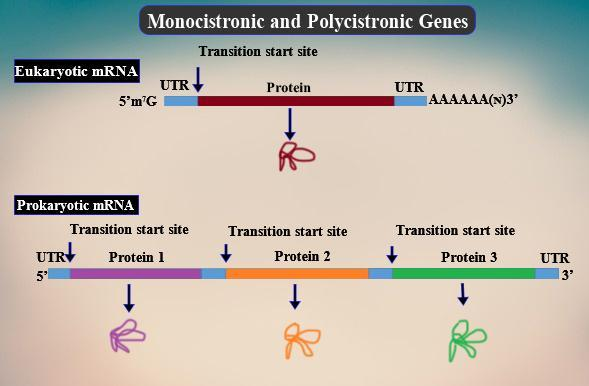
Assertion: Transcription unit is often monocistronic in eukaryotes and polycistronic in prokaryotes.
Reason: Exons do not appear in mature RNA, introns appear in the mature RNA.
(a) Assertion and Reason are true, Reason is the correct explanation of Assertion.
(b) Assertion and Reason are true, Reason is not the correct explanation of Assertion.
(c) Assertion is true, Reason is false.
(d) Assertion is false, Reason is true.
Answer
570k+ views
Hint: The segment of DNA that is equivalent to a gene specifies a single functional unit. Cistron is a segment of DNA that codes for one polypeptide.
Complete answer:
A Transcription unit refers to the sequence of nucleotides present in the DNA required for the formation of an RNA. It is monocistronic in eukaryotes and polycistronic in prokaryotes. It consists of a promoter region, structural gene, and a termination region. The monocistronic structural gene of the eukaryotes has interrupting coding sequences between them. The mature RNA or mRNA contains only exons and not introns (intervening sequences) . The process of removal of introns is known as ‘splicing’.

A gene can be monocistronic or polycistronic.
- Monocistronic mRNA is where only one gene is expressed from a promoter region. Each of them has its own promoter and terminator region.
- Polycistronic mRNA is the one that encodes several proteins. It is characteristic of many bacterial and chloroplast mRNAs. Polycistronic mRNAs consist of a leader sequence that precedes the first gene. Here many genes are present per promoter region.
So, the correct answer is ‘(c) Assertion is true, Reason is false'.
Note:
- The two strands of DNA in a structural gene possess opposite polarity. The strand having 3’ to 5’ polarity acts as the template strand and the other strand is known as a coding strand.
- The promoter is located ‘upstream' i.e. towards the 5’ end of the structural DNA. It provides the binding site for the RNA polymerase.
Complete answer:
A Transcription unit refers to the sequence of nucleotides present in the DNA required for the formation of an RNA. It is monocistronic in eukaryotes and polycistronic in prokaryotes. It consists of a promoter region, structural gene, and a termination region. The monocistronic structural gene of the eukaryotes has interrupting coding sequences between them. The mature RNA or mRNA contains only exons and not introns (intervening sequences) . The process of removal of introns is known as ‘splicing’.

A gene can be monocistronic or polycistronic.
- Monocistronic mRNA is where only one gene is expressed from a promoter region. Each of them has its own promoter and terminator region.
- Polycistronic mRNA is the one that encodes several proteins. It is characteristic of many bacterial and chloroplast mRNAs. Polycistronic mRNAs consist of a leader sequence that precedes the first gene. Here many genes are present per promoter region.
So, the correct answer is ‘(c) Assertion is true, Reason is false'.
Note:
- The two strands of DNA in a structural gene possess opposite polarity. The strand having 3’ to 5’ polarity acts as the template strand and the other strand is known as a coding strand.
- The promoter is located ‘upstream' i.e. towards the 5’ end of the structural DNA. It provides the binding site for the RNA polymerase.
Recently Updated Pages
Master Class 12 Business Studies: Engaging Questions & Answers for Success

Master Class 12 Economics: Engaging Questions & Answers for Success

Master Class 12 English: Engaging Questions & Answers for Success

Master Class 12 Maths: Engaging Questions & Answers for Success

Master Class 12 Social Science: Engaging Questions & Answers for Success

Master Class 12 Chemistry: Engaging Questions & Answers for Success

Trending doubts
What are the major means of transport Explain each class 12 social science CBSE

Which are the Top 10 Largest Countries of the World?

Draw a labelled sketch of the human eye class 12 physics CBSE

How much time does it take to bleed after eating p class 12 biology CBSE

Explain sex determination in humans with line diag class 12 biology CBSE

Differentiate between homogeneous and heterogeneous class 12 chemistry CBSE




